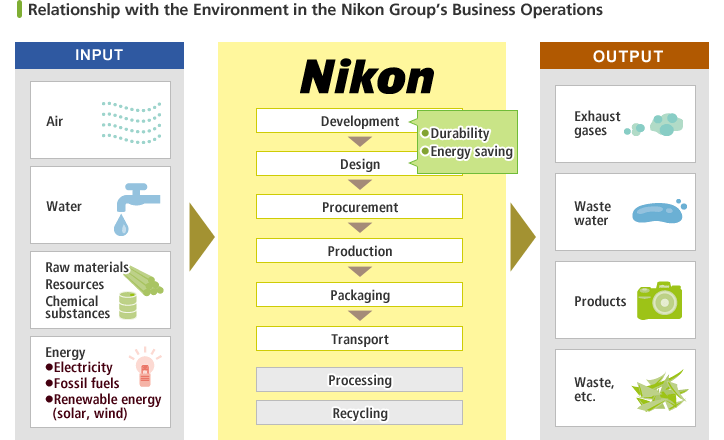Business Activities and the Environment
A company is like a living organism, functioning within the global environment. As it grows, providing products and services to society, it consumes various resources and energy and generates waste. As the need to build a recycling-based society grows, companies must also gain a clear understanding of their own environmental impacts and execute more advanced ecological management.
In addition to making steady efforts to reduce waste and other environmental impacts, the Nikon Group has also been actively engaged in its own unique activities, a notable example of which is the development of Eco-glass*, which has an amazingly small environmental footprint. During the year ended March 31, 2012, we sought to expand the scope of our environmental management system, and we continued to focus our efforts on CO2 emissions reduction and on the reduction and management of hazardous chemical substances.

- *Eco-glass
The Nikon Group developed lead- and arsenic-free optical glass for use in the lenses and prisms of optical devices, and calls this type of glass "Eco-glass." The use rate of Eco-glass in optical systems has reached 100% in most Nikon products.
Nikon Group's Principal Environmental Impacts (for year ended March 31, 2012)
| INPUT | Nikon Corporation facilities | Group manufacturing companies in Japan | Units | |
|---|---|---|---|---|
| Energy | Electricity | 160,695 | 92,159 | MWh |
| City gas | 6,013 | 1,425 | Thousand Nm3 | |
| Liquefied Petroleum Gas(LPG) | 422 | 2,155 | t | |
| Heavy oil | 10 | 836 | kl | |
| Kerosene, light oil, etc. | 49 | 124 | kl | |
| Water | 2,126 | 899 | Thousand m3 | |
| PRTR* substances | 2-aminoethanol | 1.573 | 0 | t |
| Ferric chloride | 0 | 4.800 | t | |
| Hexavalent chromium compounds | 0 | 2.071 | t | |
| Chromium and trivalent chromium compounds | 0 | 1.791 | t | |
| Dichloropentafluoropropane | 0 | 1.475 | t | |
| Toluene | 0 | 3.887 | t | |
| Lead compounds | 11.602 | 0 | t | |
| 1-bromopropane | 27.232 | 54.782 | t | |
| Boron compounds | 3.023 | 17.138 | t | |
| OUTPUT | Nikon Corporation facilities | Group manufacturing companies in Japan | Units | |
|---|---|---|---|---|
| CO2 emissions | Electricity | 60,290 | 36,636 | t-CO2 |
| City gas | 13,492 | 3,271 | t-CO2 | |
| Liquefied Petroleum Gas (LPG) | 1,265 | 6,463 | t-CO2 | |
| Heavy oil | 27 | 2,265 | t-CO2 | |
| Kerosene, light oil, etc. | 127 | 310 | t-CO2 | |
| PRTR substances emissions to the air | 2-aminoethanol | 0 | 0 | t |
| Ferric chloride | 0 | 0 | t | |
| Hexavalent chromium compounds | 0 | 0 | t | |
| Chromium and trivalent chromium compounds | 0 | 0 | t | |
| Dichloropentafluoropropane | 0 | 1.382 | t | |
| Toluene | 0 | 3.116 | t | |
| Lead compounds | 0.008 | 0 | t | |
| 1-bromopropane | 24.772 | 40.875 | t | |
| Boron compounds | 0.004 | 0.024 | t | |
| Wastes including valuable resources | Amount discharged | 3,123 | 2,610 | t |
| Amount recycled | 3,103 | 2,458 | t | |
| Amount of landfill | 8 | 89 | t | |
- Scope of Data
Nikon Corporation facilities: Head Office, and Oi, Yokohama, Sagamihara, Kumagaya, Mito and Yokosuka Plants
Group manufacturing companies in Japan: Tochigi Nikon Corporation, Tochigi Nikon Precision Co., Ltd., Sendai Nikon Corporation, Miyagi Nikon Precision Co., Ltd., Kurobane Nikon Co., Ltd., Hikari Glass Co., Ltd., TNI Industry Co., Ltd.
- *PRTR
The "Pollutant Release and Transfer Register" system is a system used by governments to collect, tabulate, and disclose data on chemical substances that might have harmful effects on human health and ecosystems. They are identified and reported to governments once per year by companies.
